Read Part 1 on Combat Training. Part 2 on Firepower. Part 3 on Tactics and Doctrine.
By Dmitry Filipoff
Introduction
The nature of a system’s technical performance is an important foundation for developing tactics and gauging readiness. Naval warfare is especially technically intensive given that a modern warship is an advanced machine made up of many complex systems.
Combat systems are rapidly evolving in the Information Age and are frequently upgraded through new software updates. This adds to the challenging of maintaining current skills and can require a force to regularly retrain its people. However, warfighting culture characterized by scripted training can mask a decline in technical competence. Such a decline can be seen in how standards fell for some of the most important tools that help the Navy guard against tactical surprise.
Environmental Factors
When American warships came under missile fire in the Red Sea two years ago they could have been far better prepared. Key environmental data that would affect the parameters of any anti-air engagement was left unaccounted for, thereby contributing an important degree of tactical surprise. Many years earlier the Navy had finalized key tools and procedures that would promise a significant evolution in environmental awareness and would have greatly mitigated this sort of tactical surprise. Somehow these tools never made it into the fleet in time.
John Hopkins University Applied Physics Laboratory (JHU APL) has been at the forefront of the Navy’s technology development for decades, including leading work on networking and surface-to-air missile capabilities. In 1982 the Navy’s Aegis Program Office began supporting JHU APL work on radar propagation models. This effort intended to more precisely understand the performance of the Aegis combat system and better account for environmental variables.1 JHU APL expounded on the important tactical implications of knowing those environmental variables:
“Environmental impacts on missile detection can be complex. The environment may limit radar detection ranges and cause degradations in track continuity through the effects of land, sea, and precipitation clutter. Communications systems may experience outages or periods of increased interference. Weapon systems may encounter midcourse guidance errors and variations in illuminator power-on-target and bistatic clutter into the missile, which affect the missile engagement envelope. In addition, the environment affects radar configuration, ship stationing, situational awareness, and missile doctrine selection.”2
Variables such as the temperature of the ocean and air, humidity, sea state, and wind speed have a strong effect on how radar energy propagates throughout the atmosphere. The chart below shows the range at which a target transitioned into track by an AN/SPY-1 radar across 20 Navy live fire exercises in differing environmental conditions. It shows how environmental factors can affect detection range by as much of a factor as three to four.3 It points out how firm track ranges could be reconstructed from post-exercise analysis that factored in environmental data gathered by key measuring tools such as rocketsondes and helicopters equipped with environmental sensors.
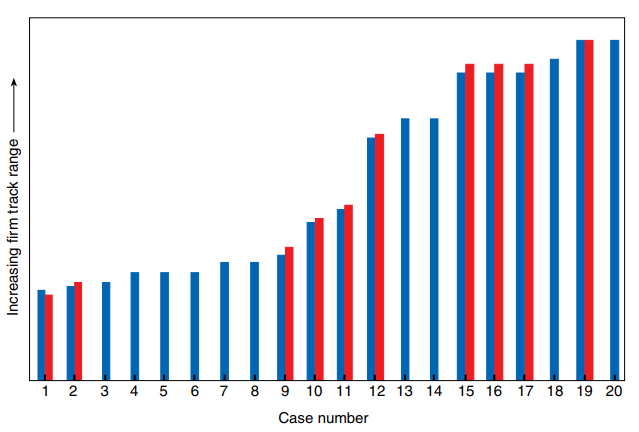
Radar energy can behave very differently when acted on by environmental factors. Radar pulses can be absorbed by the atmosphere, sapping the amount of energy that can be reflected back toward the receiver. Ducting can create radar holes and skip zones where targets cannot be detected. Refraction can even make targets appear to change direction. Atmospheric effects can also worsen radar clutter on the ocean surface hundreds of miles away from the radar.4
These factors combine to affect the key performance metric of probability of detection and can even create false contacts. Because radar energy acted on by environmental phenomena will often have more unpredictable and complex behavior compared to simpler line-of-sight detection these effects can challenge radar clutter rejection algorithms that are built into combat systems.
One of the most significant tactical implications of the environment is that certain conditions can allow a ship to break through the fog of war and see through the radar horizon limitation. Refracted radar energy can travel far along the surface and allow a ship to detect a sea-skimming target for many tens of miles below and beyond the radar horizon. Environmental awareness is therefore critical to improving threat perception and adding to a ship’s depth of fire in a most crucial zone of tactical action.

These effects combine to make mastering environmental awareness a major tactical priority. A tactical memorandum (TACMEMO) issued by the Surface Warfare Development Group in 1995 reinforced this point:
“To adequately define expected detection ranges for a given threat, an accurate assessment of the environment and its impact on sensor systems and employment is required. Depending on the environmental conditions being experienced, system performance could be enhanced or degraded. The primary environmental factors which impact detection ranges are temperature, atmospheric pressure, relative humidity, and local weather. The operating environment (e.g. near land/overland, littoral, or open ocean) also (affects) ranges.”5
These environmental effects are known, but the operational challenge is in accurately measuring them in real time and then making the necessary tactical adjustments.6 Potential solutions take the form of environmental sensors as well as modeling software that is wedded to combat systems. However, while shipboard sensors and measurements can collect environmental data, certain tools are required to gather additional data beyond what can only be gathered from the deck of a ship in order to produce higher-fidelity models.
High-quality environmental assessments were proven to require crucial range-dependent data that must be collected by periodically launched tools such as helicopters equipped with environmental sensors. JHU APL’s prototype SEAWASP system would model environmental conditions and would monitor the need to launch an expendable tool called a rocketsonde that was considered “the most effective of the expendable sensor packages for providing real-time environmental information” and where the rocketsonde was described as “essential for supporting radar performance assessments under many conditions.”7 JHU APL scientists also described the environmental helicopter as “the platform of choice” and suggested “the future may see environmental sensors on operational helicopters.”

By 2001 these systems were tested by operational units in several deployments and received enthusiastic reviews for inclusion in future Aegis baselines. The Navy Program Executive Office for Theater Surface Combatants (PEO TSC) asked JHU APL to plan to backfit their prototype SEAWASP environmental assessment capability onto existing ships and for incorporation into future system baselines.8 Guidance for using the SPY radar to help determine the presence of atmospheric effects was included in the form of appendices to the Aegis TACMEMO.9 Helicopter-based environmental assessment was mandated for Aegis Combat Systems Ship Qualification Trials (CSSQTs).
Yet somehow these efforts fell flat. Despite adequate testing and strong recommendations that the Navy widely field measuring tools like rocketsondes and helicopter-based sensors it appears these simple yet critical systems are almost nowhere to be found in the Navy’s operational forces today.
The Surface and Mine Warfighting Development Center (SMWDC) described the main lessons learned from the 2016 Red Sea attacks:
“The first and perhaps most significant lesson emerged from observing the impact of the Red Sea littoral environment on combat-system performance during an actual engagement. Until the events in October, the best understanding of environmental impact on system performance had come from computer simulations and live-fire exercises in the less-challenging conditions in the Virginia Capes or Southern California operational areas…We have updated our AWS, SSDS, and SPY radar doctrines to account for environmental impacts to system performance previously unobserved during a live Standard missile engagement.”10
Previously unobserved environmental conditions may have turned into tactical surprise in part because the Navy’s best understanding of these variables may have come from only a couple areas close to home that feature test ranges. Fixed test ranges can constrain environmental awareness through consistent conditions. Atmospheric refractivity also happen to be far more intensive in littoral regions. However, it seems the Navy lacked key environmental awareness in one of the world’s most important maritime chokepoints that lies within the Middle East littoral that was prioritized for a generation.11
If the Navy wasn’t environmentally aware in the Red Sea because things were mostly tested near Virginia or California then what does the Navy not know about the environment in the Baltic Sea, the Mediterranean, the South China Sea, or everywhere else in the world the Navy deploys? Does the Navy have specifically-tailored doctrine statements and combat system configurations for all of these environmental conditions?
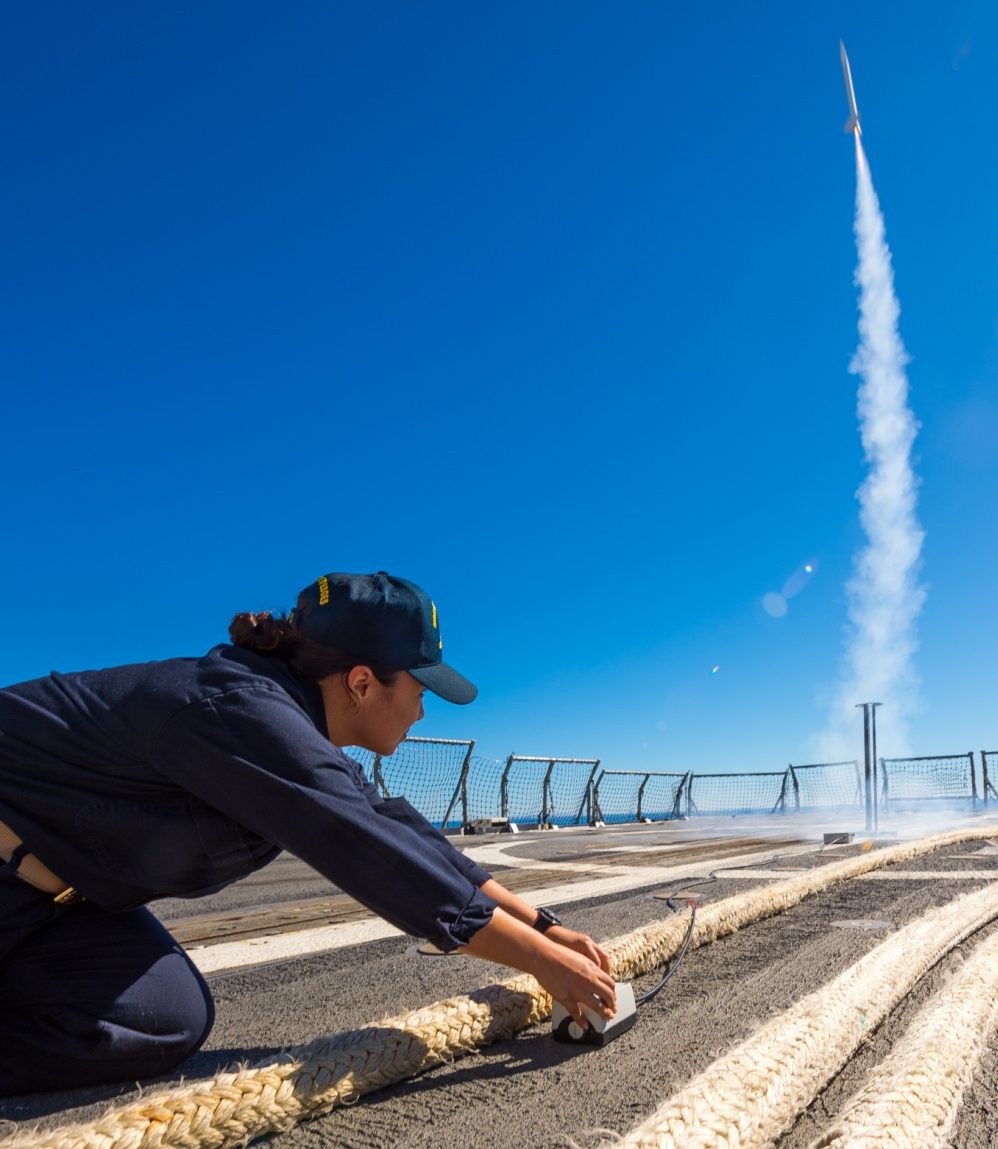
Once the environment is revealed to be crucial tactical context the force must develop an expeditionary environmental learning program as a most urgent necessity. The Navy already operates such programs to understand the environment on a global scale, such as how environmental factors have long been known to affect undersea operations and anti-submarine warfare. This understanding is operationalized through a global exercise program the surface fleet has maintained for decades, the Ship Antisubmarine Warfare Readiness and Effectiveness Measuring (SHAREM) program. Exercises under SHAREM are conducted across many geographic areas to account for different environmental factors thereby producing tailored tactics and revealing shortfalls.12 If not for environmentally-focused programs like SHAREM the tactical effectiveness of the surface fleet’s anti-submarine warfare capability would be far from ideal.
But does the Navy have a similar program that specifically seeks to account for the tactical effects of atmospheric refractivity? These environmental effects not only impact radar energy, but radiofrequency energy more generally. According to JHU APL the performance of major capabilities such as close-in-weapons systems and critical networks like the Cooperative Engagement Capability (CEC) were also “shown during field tests to strongly depend on atmospheric refractivity.”13
The tactical implications are clear and profound, especially for networked warfighting. Environmental awareness is foundational to electromagnetic awareness.
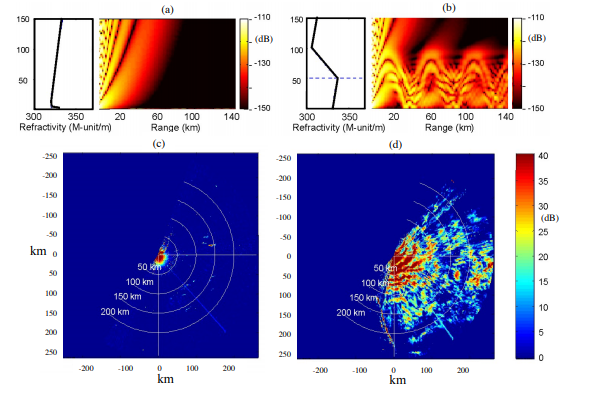
SMWDC is setting an example by charging hard and implementing fast-paced corrective action after the Red Sea attacks:
“…Surface Warfare Advanced Tactical Training and live-fire exercises have been updated to keep pace…SMWDC teams have visited every deployed and soon-to-deploy ship to ensure each has the latest TTP, training, and combat-system configuration recommendations. Ashore, the Radar Systems Controller Enhanced Course has been restored as a critical tool to ensure our SPY radar operators are prepared for what they will face in theater. In addition, SMWDC has built a case study from these events that is being included in the curricula of tactical training schoolhouses across the fleet.”
Now the question remains as to how updated understanding of the environment will translate into other parts of the Navy’s force development. SMWDC said the attacks should result in updated performance models and pointed to the problem of the Navy having only a handful of baseline datasets drawn from the Virginia Capes and Southern California areas. The widespread lack of environmental assessment tools that were described as “essential” such as rocketsondes and helicopters with special sensors may also indicate very incomplete datasets.
Whether it be training, test and evaluation, or wargaming, these insights born from the Red Sea attacks may require many other parts of the Navy to update baseline data and contemplate extensive retroactive action. Such action could take the form of replaying wargames with newly updated environmental parameters and conducting expeditionary test and evaluation in less familiar waters.
Ultimately such an important evolution in environmental awareness should have been enough to prompt rapid and wide-ranging adaptation similar to what SWMDC is doing and what was hinted at years ago. At first, the Navy did appear to be in the process of introducing expected change. The importance of atmospheric refractivity on tactical possibility was being acknowledged in the form of new programs of record, tactical memoranda, and requirements, many dating back over twenty years ago. Upgraded environmental assessments were made mandatory in at least one key part of the Navy’s business in the form of Aegis CSSQTs. Key measuring tools such as rocketsondes and helicopters with environmental sensors were tested, proven, approved of, and required relatively little effort to equip.
Somehow the system comprehensively failed, and frontline warfighters came under fire while lacking the important degree of tactical awareness those key tools contribute. Now to best anticipate tactical surprise the Navy must look to update environmental understanding on a global scale.
Sea surface currents and temperatures in the eastern Pacific Ocean (NASA)
SPY Radar
The SPY radar is the most powerful radar on the Navy’s large surface combatants, and it is perhaps the most important set of eyes for the Aegis combat system. But this critical radar suffered a decline in standards. After describing several issues with SPY radar maintenance the 2010 Balisle report noted:
“The SPY radar has historically been the best supported system in the surface Navy. If the SPY radar is one of the most important systems in the Navy and central to our BMD mission for the foreseeable future, then it is assumed that less important systems could well be in worse material condition.”14
In his article, “Is Your SPY Radar Enhanced, Nominal, or Degraded?” Captain Jim Kilby recalled the Balisle report’s warning and described his own experience in witnessing a decline in radar maintenance. After reminiscing about past standards Kilby said that somewhere along the way the surface fleet had “lost some of this spirit”and that Sailors “do not have the cultural model to fall on when they report to the ship.” This loss of spirit and culture could be possibly interpreted as the degradation of standards. Kilby felt he ultimately had to “provide that leadership” himself.15
Kilby may have felt he personally had to set a higher standard because he realized the Navy, institutionally, did not properly maintain it. The Balisle report suggested that Sailors are “perhaps losing their sense of ownership of their equipment and are more apt to want others to fix it.” Kilby relates a story where a contractor working as a combat systems instructor for his crew said he and his technicians used to have a tracking book so they “all knew where we were, combat-system performance-wise.” Captain Kilby then wondered to himself, “Why shouldn’t I know that too?”
If something can be measured then it can usually be optimized. Kilby pointed out “You can’t manage what you can’t measure,” so they “decided to measure and track key parameters to better manage the system.” He went on to discuss how he personally instituted a new process on the warship to track the performance of the SPY radar that would go “beyond a superficial indicator level.” Kilby realized he had to know the quantitative results of maintenance actions in order to know how radar performance was trending, such as with respect to key metrics like effective transmit power. He went on to personally invent and decide on a “quantitative SPY radar material goal” to provide to the crew.
But is it really the responsibility of one ship’s captain to decide what the radar material goal should be for the SPY radar, let alone invent such a standard on his own? A crew that does not have a meaningful system to track the transmit power of their radar is like an armor crewman not knowing he should boresight the main gun of a tank, or an infantryman not knowing how to sight his scope. This was Kilby’s fifth Aegis tour and he certainly wasn’t inexperienced. His career track put him inside the Navy’s surface warfare directorate, the Ballistic Missile Defense office, and he partook in the Aegis Fire Controlman Deep Dive that resulted in new training. He also happened to invent this new radar tracking system around the first ballistic missile defense patrol of a freshly upgraded cruiser, a special unit that could find itself on the frontlines of defending against nuclear attack.
Perhaps change has taken place since Kilby published about his reforms. But it suggests that for a time the Navy did not have a meaningful set of standards in place for unit leaders to effectively know the performance of one of the most critical sensors in the fleet. What was Kilby’s personal invention clearly should have already been a Navy-wide process and standard. In the end his new methods were not unique innovations, but rather rediscovered responsibilities:
“SPY radar self-sufficiency can and should be supported by outside entities, but ultimately it is a function of my behavior, interest, and leadership. It is my responsibility. Specific results of transmitter power and phase must be understood, considered, and acted upon by operators and by me. The devil is in not knowing the details. As the commanding officer, I have to be personally involved. I cannot delegate this effort.”
Target Missiles
The Navy’s lack of appreciation for the anti-ship missile threat is not confined to its own limited arsenal of such weapons, but also extends to the inventory of target missiles that seek to replicate those threats for force development. The Navy allowed a significant shortfall to emerge in its inventory of target missiles where tools that realistically represent the supersonic anti-ship missile threat are now very few and far between.
A 2005 report by the Defense Science Board described the shortfall at the time as “dire” and that the supersonic target missile inventory was “substantially deficient.” It pointed out the discrepancy between the tools on hand and the common flight profiles of weapons in the hands of great power rivals:
“The area of greatest concern to the Task Force was our gap in supersonic anti-ship cruise missiles for testing. The Russians have deployed at least three such cruise missiles that involve either sea-skimming flight profiles or a high-altitude profile involving a power dive to the target. At this time, we have no test vehicles for either flight profile.”16
Once the anti-air Talos missile was retired in the late 70s the remaining inventory was converted into Vandal target missiles. The Vandal would be the Navy’s main tool for representing the supersonic sea-skimming missile threat for decades. For other threats the AQM-37C long served as the Navy’s target for high-flying supersonic flight. However, it is incapable of maintaining supersonic speeds while executing a powered dive or sea-skimming trajectory – the two common flight profiles of supersonic missile threats the Defense Science Board noted.
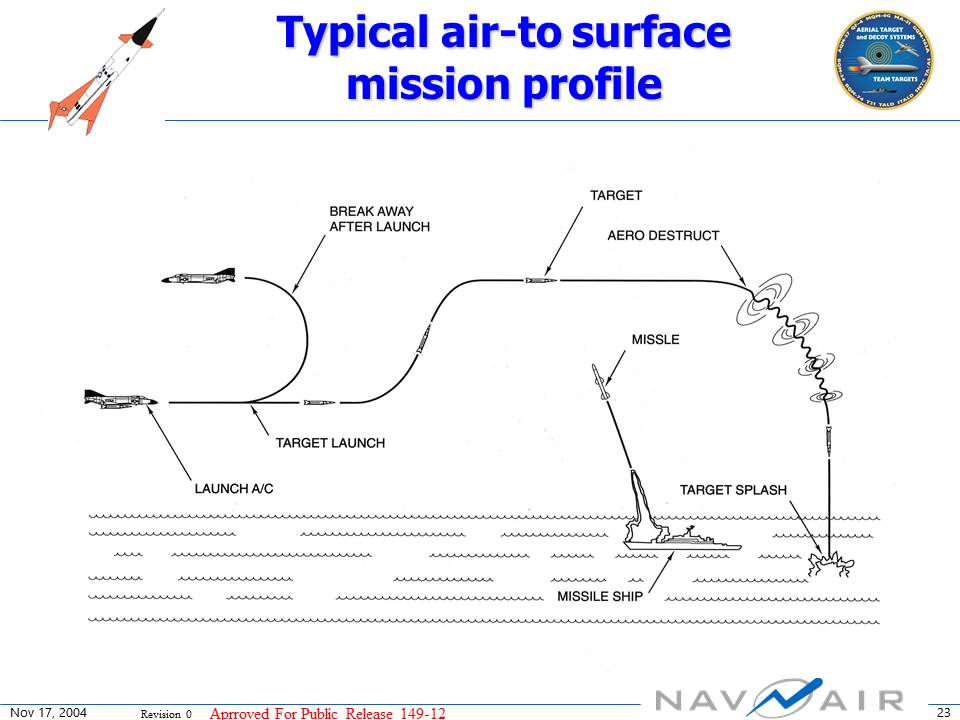
The supersonic AQM-37C and Vandal target missiles were launched dozens of times per year for decades.17 But the firing rates fell to much lower levels after they left service in the early 2000s. After a viable replacement came online in 2005 in the form of the Coyote target missile the Navy would go on to launch less than 50 targets capable of supersonic sea-skimming flight across the next ten years.18 Admiral Phil Davidson also claimed that Navy units based on the East Coast went almost 13 years without shooting down any supersonic target missiles until 2016.19

The Navy launches several hundred target missiles per year but almost all are slow, subsonic payloads that hardly represent the supersonic anti-ship missiles that are commonly found in the navies of great power competitors.20 It also appears that supersonic target missiles are almost always fired from land. This diminishes the realism of the events with respect to exploring varying environmental conditions, especially those that would be found in open-ocean warfare.21
In spite of this, the subsonic target missile that according to the Navy is its “workhorse” will be replaced by another subsonic payload.22 As more lethal supersonic and eventually hypersonic weapons proliferate the Navy’s target missile inventory will continue to be almost entirely made of subsonic payloads that fail to accurately represent these advanced threats. The disparity between the Navy’s target inventory and the true nature of the anti-ship missile threat is poised to widen further.
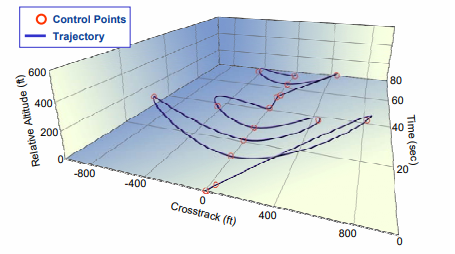
Manager, Aerial Targets Business Development Integrated Systems Western Region, Northrop Grumman Corporation, NDIA Targets 2006.)
Supersonic target missiles certainly are very expensive tools and it is impractical to expect most units to have a chance to practice with them. However, these tools are invaluable for ensuring realism for key force development activities.
Consider all the lessons SMWDC is learning and translating into the surface fleet, especially through their restarted Live Fire With a Purpose (LFWAP) events that aim to “test and validate TACMEMOs and latest tactical recommendations.”23 For the sake of tactical development and high-end readiness what good may come from firing salvos of supersonic target missiles in the general direction of some of the Navy’s finest tacticians?
Doctrine Statements
For a force that is primarily made of highly sophisticated machines technical standards are a key part of warfighting readiness. In the case of naval warfare the abovementioned technical standards have especially important tactical consequences.
Naval warfare in the missile age is notable for having transcended the boundary of human limitations. The speed and intensity of engaging a salvo of anti-ship missiles that could be seconds away from impact is a tactical challenge that is mostly beyond the ability of a human to carefully manage with real-time inputs. Therefore the combat systems of warships, perhaps best exemplified by the Aegis combat system and the Ship Self-Defense System (SSDS), must be automated to an extraordinary degree to stand a chance of defeating missiles under trying circumstances.
The role of the operator then is to program pre-set conditions and instructions into the combat system. These are known as doctrine statements, up to and including fully automated responses for highly lethal situations. These doctrine statements can be built around the characteristics and flight profiles of potential threats, and can dictate how the combat system will automatically combine the various capabilities of the ship to defeat those threats.24 These automated doctrine statements can be the Navy’s last line of defense against tactical surprise because even if Sailors are caught off guard by a sea-skimming salvo breaking over the horizon the automated combat system can carry the day.
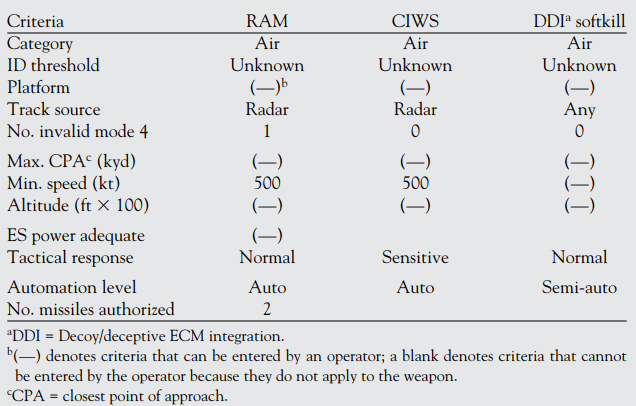
Effectively countering the anti-ship missile threat is very much a matter of crafting doctrine statements well in advance of a combat situation. Sailors should not be put in a position where they are forced to rapidly reconfigure doctrine statements in the middle of the fight in order to survive. More ideally, Sailors will be familiar with a variety of well-tailored doctrine statements they can choose from to meet a range of situations.
It is essential to know the state of a radar’s energy output and to understand the environmental factors that dictate how that radar energy propagates. Both are fundamental baseline context for ascertaining the ability to detect targets, knowing how to configure combat systems, and managing emissions control.25 Certain environmental conditions can also raise the probability of false alarms, and there may be situations with little opportunity to intervene in an automated response to make timely corrections.
How well does the Navy understand the nature of guiding a semi-active homing weapon such as the Standard Missile through environmental conditions below the radar horizon? How well has the Navy configured doctrine statements to guard against skip zones and other environmental effects that complicate how a ship can see and engage targets through its radar?

Consider the Red Sea combat events and how new doctrine statements and combat system configurations were key outputs from the learning experience, and how these updates were based on a specific environmental context. The Navy should look to this experience and see how it can learn similar lessons minus the risks of real combat. As an engine of tactical development can the Navy conduct expeditionary Live Fire With a Purpose events similar in design to the SHAREM program? Could the Navy produce refined doctrine statements by firing advanced target missiles in varying environmental conditions that resemble forward areas? Such a program could do well to sharpen the tool of Aegis.
Poor environmental awareness, low-fidelity target missiles, and lack of key radar performance metrics forms a recipe for less than ideal doctrine statements. Failing to maintain high technical standards across these areas suggests very suboptimal programming may be built into the automated combat functions of warships across the world.
Part Five will focus on Material Condition and Availability.
Dmitry Filipoff is CIMSEC’s Director of Online Content. Contact him at Nextwar@cimsec.org.
References
1. J. Ross Rottier, John R. Rowland, Gerald C. Konstanzer, Julius Goldhirsh,
and G. Daniel Dockery, “APL Environmental Assessment for Navy Anti-Air Warfare,” JHU APL Technical Digest, Volume 22, Number 4, 2001. https://pdfs.semanticscholar.org/8400/6b65f5cac14e71239fc5aa7e400444007036.pdf
2. J. Ross Rottier, John R. Rowland, Gerald C. Konstanzer, Julius Goldhirsh,
and G. Daniel Dockery, “APL Environmental Assessment for Navy Anti-Air Warfare,” JHU APL Technical Digest, Volume 22, Number 4, 2001. https://pdfs.semanticscholar.org/8400/6b65f5cac14e71239fc5aa7e400444007036.pdf
3. James J. Sylvester, Gerald C. Konstanzer, J. Ross Rottier, G. Daniel Dockery,
and John R. Rowland, “Aegis Anti-Air Warfare Tactical Decision Aids,” JHU APL Technical Digest, Volume 22, Number 4, 2001. http://www.jhuapl.edu/techdigest/TD/td2204/Sylvester.pdf
4. Naval Surface Warfare Dalhgren Division, “Sensors: Challenges and Solutions for the 21st Century,” Leading Edge, Volume 7, Issue No. 2. https://www.navsea.navy.mil/Portals/103/Documents/NSWC_Dahlgren/LeadingEdge/Sensors/Sensors03.pdf
5. John David Whalen, “Comparison of evaporation duct height measurement methods and their impact on radar propagation estimates,” Naval Postgraduate School, 1998. https://calhoun.nps.edu/bitstream/handle/10945/8118/comparisonofevap00whal.pdf?sequence=1
6. Committee on Environmental Information for Naval Use, Ocean Studies Board of the National Research Council of the National Academies, “Environmental Information for Naval Warfare,” 2003. https://www.nap.edu/read/10626/chapter/11#148
7. J. Ross Rottier, John R. Rowland, Gerald C. Konstanzer, Julius Goldhirsh,
and G. Daniel Dockery, “APL Environmental Assessment for Navy Anti-Air Warfare,” JHU APL Technical Digest, Volume 22, Number 4, 2001. https://pdfs.semanticscholar.org/8400/6b65f5cac14e71239fc5aa7e400444007036.pdf
8. James J. Sylvester, Gerald C. Konstanzer, J. Ross Rottier, G. Daniel Dockery,
and John R. Rowland, “Aegis Anti-Air Warfare Tactical Decision Aids,” JHU APL Technical Digest, Volume 22, Number 4, 2001. http://www.jhuapl.edu/techdigest/TD/td2204/Sylvester.pdf
9. James J. Sylvester, Gerald C. Konstanzer, J. Ross Rottier, G. Daniel Dockery,
and John R. Rowland, “Aegis Anti-Air Warfare Tactical Decision Aids,” JHU APL Technical Digest, Volume 22, Number 4, 2001. http://www.jhuapl.edu/techdigest/TD/td2204/Sylvester.pdf
10. Rear Admiral John Wade and Lieutenant Timothy Baker, USN, “Red Sea Combat Generates High Velocity Learning,” U.S. Naval Institute Proceedings, September 2017. https://www.usni.org/magazines/proceedings/2017-09/red-sea-combat-generates-high-velocity-learning
11. J. Ross Rottier, John R. Rowland, Gerald C. Konstanzer, Julius Goldhirsh,
and G. Daniel Dockery, “APL Environmental Assessment for Navy Anti-Air Warfare,” JHU APL Technical Digest, Volume 22, Number 4, 2001. https://pdfs.semanticscholar.org/8400/6b65f5cac14e71239fc5aa7e400444007036.pdf
12. OPNAV INSTRUCTION 3360.30D, “SHIP ANTISUBMARINE WARFARE READINESS AND EFFECTIVENESS MEASURING PROGRAM,” Chief of Naval Operations, January 23, 2018. https://doni.documentservices.dla.mil/Directives/03000%20Naval%20Operations%20and%20Readiness/03-300%20Warfare%20Techniques/3360.30D.pdf
Excerpts:
4. Objective. The objective of the SHAREM Program is to assess surface ship ASW readiness and effectiveness and recommend solutions for ASW warfighting gaps. This objective is met via the collection and analysis of sensor and environmental data in tactically relevant geographic operating areas.
a. SHAREM exercises will evaluate surface force ASW systems and tactics, techniques, and procedures in tactically-relevant environments. Evaluation of current and emerging threats and environments of national interest, as recommended by the fleet and force commanders and as directed by the Office of the Chief of Naval Operations, Surface Warfare Division (OPNAV N96), will lead to development of tactically-focused exercise events and collection of tactically significant environmental data.
b. Environmental data will be collected in coordination with systems commands, naval laboratories, and Commander, Naval Meteorology and Oceanography Command.
c. SHAREM-sponsored exercises, Submarine Command Course (SCC) mini-wars, and limited objective experiments provide the opportunity to collect and analyze data to assess the full scope of surface ship ASW operations through the detect-to-engage sequence. Exercises should be conducted on underwater tracking ranges or in environments that reflect areas of
operational interest.
See also: Naval Surface and Minewarfighting Development Center SNA National Symposium Edition Newsletter, January 2018. https://www.public.navy.mil/surfor/nsmwdc/Documents/SMWDC_January_2018_Newsletter.pdf
Excerpt:
“SHAREM has operated for 48 years and has transitioned from SWDG to SURFDEVRON, SURFDEVRON to STDG, and finally STDG to SMWDC, where it now resides. SHAREM is highly effective at informing future ship builds, releasing tactical memos (TACMEMOs) for future integration into tactics, techniques and procedures, and maintaining a database of all data collected.”
13. James J. Sylvester, Gerald C. Konstanzer, J. Ross Rottier, G. Daniel Dockery,
and John R. Rowland, “Aegis Anti-Air Warfare Tactical Decision Aids,” JHU APL Technical Digest, Volume 22, Number 4, 2001. http://www.jhuapl.edu/techdigest/TD/td2204/Sylvester.pdf
14. Vice Admiral Phillip Balisle, USN (ret.), “Fleet Review Panel of Surface Force Readiness,” February 26, 2010. http://www.sailorbob.com/files/foia/FRP%20of%20Surface%20Force%20Readiness%20(Balisle%20Report).pdf
15. Captain Jim Kilby, USN, “Is Your SPY Radar Enhanced, Nominal, or Degraded?” U.S. Naval Institute Proceedings, January 2012. https://www.usni.org/magazines/proceedings/2012-01/your-spy-radar-enhanced-nominal-or-degraded
16. “Report of the Defense Science Board Task Force on Aerial Targets,” Defense Science Board, October 2005. http://www.dtic.mil/dtic/tr/fulltext/u2/a441466.pdf
17. Presentation by Steve Berkel, AQM-37 Projection Coordinator, NAVAIR, 2004. https://www.google.com/search?q=STEVE+BERKEL+ppt+navair&oq=STEVE+BERKEL+ppt+navair+&aqs=chrome..69i57.4393j0j9&sourceid=chrome&ie=UTF-8
18. “Orbital ATK Successfully Launches Two Coyote Targets for the U.S. Navy,” Businesswire.com, June 17, 2005. https://www.businesswire.com/news/home/20150617005337/en/Orbital-ATK-Successfully-Launches-Coyote-Targets-U.S.
See also: 49th Annual Targets, UAVs, & Range Operations Symposium & Exhibition, 2011. http://www.dtic.mil/dtic/tr/fulltext/u2/1005858.pdf#page=142
19. Megan Eckstein, “Warfighting Development Centers, Better Virtual Tools Give Fleet Training a Boost,” U.S. Naval Institute News, February 23, 2017. https://news.usni.org/2017/02/23/fleet-training-getting-a-boost-through-better-lvc-tools-warfighting-development-centers
20. Presentation by John VanBrabant Manager, Aerial Targets Business Development Integrated Systems Western Region, Northrop Grumman Corporation, NDIA Targets 2006. https://ndiastorage.blob.core.usgovcloudapi.net/ndia/2006/targets/VanBrabant.pdf
21. Captain Pat Buckley Program Manager PMA-208, Aerial Target & Decoy Systems, October 10, 2008. https://ndiastorage.blob.core.usgovcloudapi.net/ndia/2008/targets/Friday/Buckley.pdf
22. Subsonic Aerial Target System (SSAT), Naval Air Systems Command. http://www.navair.navy.mil/index.cfm?fuseaction=home.displayPlatform&key=2F240C2D-621A-42B2-9186-20B3F2469236
For “workhorse” see: Captain Pat Buckley Program Manager PMA-208, Aerial Target & Decoy Systems, October 10, 2008. https://ndiastorage.blob.core.usgovcloudapi.net/ndia/2008/targets/Friday/Buckley.pdf
23. Presentation by Naval Surface and Mine Warfighting Development Center (SMWDC) at West 2018 conference. https://www.westconference.org/West18/Custom/Handout/Speaker0_Session6209_1.pdf
SMWDC Quarterly, Volume 1, Issue, December 2016. https://www.public.navy.mil/surfor/nsmwdc/Documents/SMWDC_Newsletter_16DEC2016-DAPS.PDF
24. “The Navy’s New Aegis,” Semaphore, Sea Power Centre Australia, Issue 07, 2009. http://www.navy.gov.au/sites/default/files/documents/Semaphore_2009_7.pdf
25. James J. Sylvester, Gerald C. Konstanzer, J. Ross Rottier, G. Daniel Dockery,
and John R. Rowland, “Aegis Anti-Air Warfare Tactical Decision Aids,” JHU APL Technical Digest, Volume 22, Number 4, 2001. http://www.jhuapl.edu/techdigest/TD/td2204/Sylvester.pdf
Excerpt: “The Aegis community had concluded that accurate combat system performance assessments were valuable to the Aegis warfighter in terms of ship stationing, adapting radar configuration appropriately to the environment, and maintaining awareness of self defense capabilities and limitations.”
Featured Image: SPY radar array on Aegis-equipped DDG-175 escort ship “Miyoko” of the Japanese Maritime Self Defense Forces via Marie’s Garden Blog.

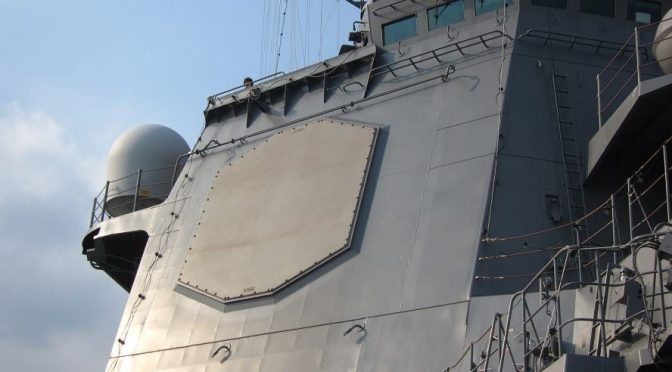
The lack of fleet wide technical standards for operation of key missile defense systems is troubling, to say the least.
But I think it is symptomatic of a sort of game of ostrich being played by today’s naval and Congressional leaders. If the people in charge are afraid of the answer to the question, “how well prepared are we to fight off large barrages of sea skimming anti ship cruise missiles?”, then people will tend to ignore the processes that actually reveal the weakness.
If one of the world’s most sophisticated and capable surface warships (an Arleigh Burke DDG equipped with AEGIS, SPY, anti-antiship missiles, and ECM) barely fights off a half a handful of very old, unsophisticated ASCMs fired by a ragtag group of Houthi rebels, then one shudders to think what such a ship will do if targeted by 50 or 100 missiles fired by the PLAN or Russian air force?
The economics of such barrages are very apparent – such ASCMs cost relatively little, on average less than $1M each. Throw 100 of them at a near $2B warship, or worse, at a $14B CVN, and the economics clearly favor the attacker, not the defender. Especially when even one or two missile hits in a vital spot can take even a huge ship out of the battle.
The logistics of a mass salvo of ASCMs is also not hard to accomplish. Land based ASCM launchers can number in the hundreds or even thousands, and feature unlimited magazines, and being mobile and hide-able, cannot be taken out in advance by a surprise attack. Then also, our near peer opponents like Russia and China can field hundreds of supersonic attack fighters,capable of deploying from 2 to 6 ASCMs each .. and long range heavy bombers are able to deploy up to a couple dozen such missiles each, and it is easily plausible for massive ASCM salvos to be directed at each of our deployed warships.
Unless and until this reality is addressed with superior sensor networks and massive counterfires achievable only with weapons with cheap, deep magazines like the railgun or directed energy weapons, or extremely powerful and reliable ECM, the survivability of any surface fleet – ours or theirs – in a naval war is doubtful in the extreme. It is quite likely that the opening days of a naval war will see effectively all surface combatants sitting on the bottom. Then what?
Maybe it is long past time now to reconsider the current massive investment in surface warships. I personally believe that the future of the Navy is mainly found in submarines and long range land-based aircraft. In fact, it’s been that way since the opening days of World War Two, but surface ship officers 73 years later are still loathe to admit that reality.
Yet this particular elephant in the room continues to be ignored.